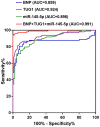Differentially expressed TUG1 and miR-145-5p indicate different severity of chronic heart failure and predict 2-year survival prognosis
- PMID: 34659508
- PMCID: PMC8515550
- DOI: 10.3892/etm.2021.10796
Differentially expressed TUG1 and miR-145-5p indicate different severity of chronic heart failure and predict 2-year survival prognosis
Abstract
Long non-coding RNAs (lncRNAs) and microRNAs (miRs) have critical roles in the progression of various diseases. The present study aimed to investigate the levels and clinical significance of lncRNA taurine upregulated gene 1 (TUG1) and miR-145-5p in patients with chronic heart failure (CHF) and explore their indicative value regarding disease severity. TUG1 and miR-145-5p levels were detected by reverse-transcription quantitative PCR. Correlations were examined using Pearson's correlation analysis. Receiver operating characteristic analysis was used to evaluate the diagnostic value of TUG1, miR-145-5p and brain natriuretic peptide (BNP). Survival analysis was performed by the Kaplan-Meier method. Cox regression analysis was used to evaluate the prognostic value of TUG1 and miR-145-5p. The levels of interleukin-6 and tumor necrosis factor-α in serum were detected by ELISA. The results indicated that TUG1 was upregulated and miR-145-5p was downregulated in patients with CHF and they were negatively correlated. TUG1 and miR-145-5p were associated with the left ventricle ejection fraction and were able to indicate the severity of CHF. Serum TUG1 and miR-145-5p had a certain diagnostic value and the combination of BNP, TUG1 and miR-145-5p had high diagnostic accuracy. TUG1 and miR-145-5p were closely associated with overall survival and may function as independent prognostic biomarkers for patients with CHF. In addition, TUG1 and miR-145-5p levels were markedly correlated with inflammation in CHF. Upregulated TUG1 and downregulated miR-145-5p may indicate the severity of CHF, may serve as diagnostic and prognostic biomarkers and may be involved in CHF progression by regulating inflammatory responses.
Keywords: TUG1; chronic heart failure; diagnosis; inflammation; miR-145-5p; prognosis; severity.
Copyright: © Zhu et al.
Conflict of interest statement
The authors declare that they have no competing interests.
Figures





Similar articles
-
Clinical significance of the long non-coding RNA NEAT1/miR-129-5p axis in the diagnosis and prognosis for patients with chronic heart failure.Exp Ther Med. 2021 May;21(5):512. doi: 10.3892/etm.2021.9943. Epub 2021 Mar 19. Exp Ther Med. 2021. PMID: 33791021 Free PMC article.
-
miR-182-5p combined with brain-derived neurotrophic factor assists the diagnosis of chronic heart failure and predicts a poor prognosis.J Cardiothorac Surg. 2022 Apr 30;17(1):88. doi: 10.1186/s13019-022-01802-0. J Cardiothorac Surg. 2022. PMID: 35501813 Free PMC article.
-
Long non-coding RNA TUG1 contributes to tumorigenesis of human osteosarcoma by sponging miR-9-5p and regulating POU2F1 expression.Tumour Biol. 2016 Nov;37(11):15031-15041. doi: 10.1007/s13277-016-5391-5. Epub 2016 Sep 22. Tumour Biol. 2016. PMID: 27658774
-
Long Non-coding RNA TUG1 Sponges Mir-145a-5p to Regulate Microglial Polarization After Oxygen-Glucose Deprivation.Front Mol Neurosci. 2019 Sep 10;12:215. doi: 10.3389/fnmol.2019.00215. eCollection 2019. Front Mol Neurosci. 2019. PMID: 31551710 Free PMC article.
-
lncRNA TUG1 as potential novel biomarker for prognosis of cardiovascular diseases.Epigenomics. 2023 Dec;15(23):1273-1290. doi: 10.2217/epi-2023-0242. Epub 2023 Dec 13. Epigenomics. 2023. PMID: 38088089 Review.
Cited by
-
The Application Value of Brain Natriuretic Peptide in the Prognostic Evaluation of Patients With Chronic Left Heart Failure.Cardiovasc Ther. 2025 Aug 16;2025:9353377. doi: 10.1155/cdr/9353377. eCollection 2025. Cardiovasc Ther. 2025. PMID: 40861247 Free PMC article.
-
Prognostic and predictive microRNA panels for heart failure patients with reduced or preserved ejection fraction: a meta-analysis of Kaplan-Meier-based individual patient data.BMC Med. 2025 Jul 7;23(1):409. doi: 10.1186/s12916-025-04238-0. BMC Med. 2025. PMID: 40624658 Free PMC article.
-
Exploring the therapeutic mechanisms of heart failure with Chinese herbal medicine: a focus on miRNA-mediated regulation.Front Pharmacol. 2024 Nov 5;15:1475975. doi: 10.3389/fphar.2024.1475975. eCollection 2024. Front Pharmacol. 2024. PMID: 39564110 Free PMC article. Review.
-
Non-coding RNAs in the pathophysiology of heart failure with preserved ejection fraction.Front Cardiovasc Med. 2024 Jan 8;10:1300375. doi: 10.3389/fcvm.2023.1300375. eCollection 2023. Front Cardiovasc Med. 2024. PMID: 38259314 Free PMC article. Review.
-
Traditional Chinese medicine as an adjunctive therapy improves cardiac function and reduces serum inflammatory markers in patients with chronic heart failure.J Med Biochem. 2025 Jun 13;44(3):507-514. doi: 10.5937/jomb0-54440. J Med Biochem. 2025. PMID: 40821638 Free PMC article.
References
-
- Su Q, Zhang P, Yu D, Wu Z, Li D, Shen F, Liao P, Yin G. Upregulation of miR-93 and inhibition of LIMK1 improve ventricular remodeling and alleviate cardiac dysfunction in rats with chronic heart failure by inhibiting RhoA/ROCK signaling pathway activation. Aging (Albany NY) 2019;11:7570–7586. doi: 10.18632/aging.102272. - DOI - PMC - PubMed
LinkOut - more resources
Full Text Sources
